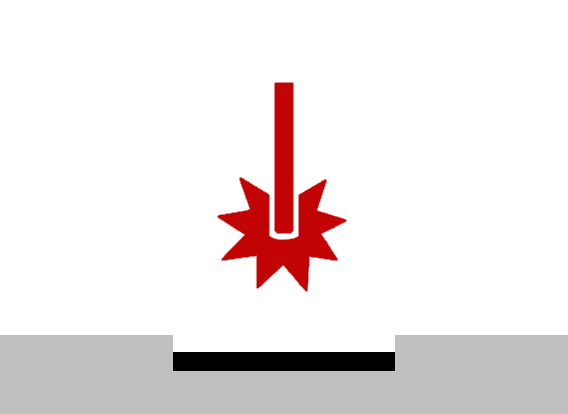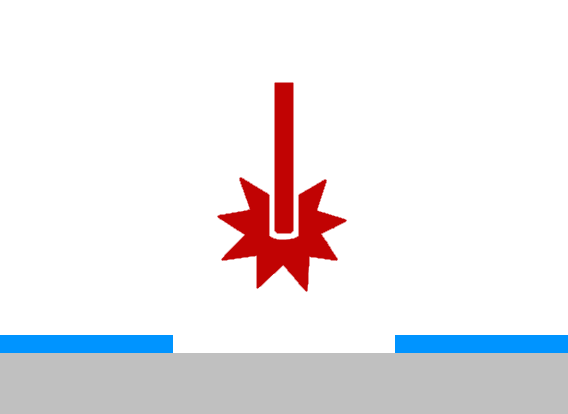LASER MARKING
ACCURATE, PERMANENT, NON-CONTACT
WHAT IS LASER MARKING?
Laser marking alters the properties and appearance of the targeted material’s surface. Laser marking differs from laser etching or laser engraving, even though the terms are often used interchangeably. Laser marking is more common than laser etching or laser engraving. Laser marking can change the color of the base material through chemical or molecular alteration. Molecular alteration, chemical alteration, foaming, charring, melting, annealing, and carbon migration are some of the different processes that are achieved from laser marking different materials with varying wavelengths of light and specific laser parameters.
In laser marking, color contrast and surface texture are a couple of the important considerations to keep in mind when establishing laser marking parameters.
• CONTRAST
It is undesirable, for example, to make a black laser mark on black material. If you did this, you would not easily be able to see the laser marking on that part. The picture to the right showing white laser marking on a black part is an example of excellent marking contrast.
• SURFACE PRESERVATION
Foreign body infections can be contracted from the adhesion of bacteria to medical device surfaces. The adhesion of bacteria is called bio-film adhesion and is made up of microorganisms that stick to each other and to a surface. To reduce these bio-film adhesion complications, the surface texture of the material that has been laser marked can be of significant importance to the final product. For this reason, in many cases, it is desirable to create a subsurface laser mark where the laser marking does not affect the outer surface of the target material.
When observing a subsurface laser marked area, the outer surface of the marked material will have the same sheen or light reflection characteristics when viewed under a microscope as the unmarked area of the material does. In other products, it may not be possible to achieve a subsurface laser mark. The objective is usually to create a smooth laser marked surface finish that is equal to or better than the surface finish of the original or surrounding material in order to minimize bio-film adhesion.

WHAT IS ENGRAVING AND ETCHING?

Laser etching and laser engraving are essentially the same processes and the two terms can be used interchangeably. Unlike laser marking, laser engraving or laser etching removes material by vaporizing and/or ejecting it with the laser beam. For polymers, this process is often called laser ablation. During the etching/engraving/ablation process, the laser is set to remove a certain depth and pattern of material from the part, which is somewhat similar to mechanical engraving.
BENEFITS OF LASER MARKING
Laser marking does not cause abrasions or damage to the area surrounding the target material. Laser marking leaves exact, accurate, and high-contrast marks that can easily be read by the human eye.
• THE LATEST TECHNOLOGY
Before the introduction of laser marking, the manufacturing industry provided mechanical engraving and screen printing for marking surfaces with patterns, images, text or barcodes. Mechanical engraving would often damage the products and screen printing tended to fade rather quickly from abrasion. Laser marking introduced a permanent, non-contact solution; it is an eco-friendly process that does not use paint or chemicals. It is an entirely toxic-free process that uses laser beams to affect the intended target area. For these reasons, laser marking is quickly becoming the go-to technology for part identification and labeling.
• COUNTERFEIT REDUCTION
Product counterfeiting is an unlawful imitation of a product with the intent to deceive buyers into purchasing a knock-off of the original product. Many industries are affected by counterfeit products, and understandably, the government cannot detect every counterfeited product in the marketplace. The trademark owners are often left alone battling the fake products and have to invest in tracking counterfeit sales. Counterfeit products are capable of causing massive losses for companies and are on the rise in many parts of the world. Laser marking is a process that can help prevent product counterfeiting through permanent, intricate labeling that will not distract from the original product. Laser marking is a practical anti-counterfeiting method because the laser marking can be very difficult to be identically copied.

Laser marking is hard to reproduce identically because different laser systems often produce slightly different results on the target material. Additionally, tiny, subtle and detailed anti-counterfeiting marks can be strategically placed on the product. Any industry can protect their product with a logo, brand name, or unique serial number to quickly identify counterfeit products.
COMMON TYPES OF LASER MARKING
• ANNEALING
Annealing is an oxidation process that applies heat to the material surface. Annealing usually results in a smooth, solid black mark. The color may vary based on the laser parameters used. Typical materials used with annealing are stainless steel, titanium and carbon steel.

• CARBON MIGRATION
Carbon migration is used when marking metal or metal alloys. In this laser marking process, the metal binds chemically with its carbon molecules from the heat of the laser beam. The bonding process brings the carbon properties to the surface of the material. The resultant is a dark laser marking. Typical materials used with carbon migration are stainless steel, titanium and carbon steel.

• CHARRING
Charring occurs when the base material is heated with the laser beam. The heat of the laser beam removes hydrogen and oxygen from the material and the result is a material which has a much higher content of carbon than the original material. The laser charring process is typically used on plastics.

• DISCOLORATION
Discoloration, which can change the color of the material being marked, is the result of molecular or chemical alteration of the base material. The discoloration process is typically used on plastic and rubber materials. We do abrasion testing on all discoloration marks that we develop in-house.

• FOAMING
Foaming occurs when the laser beam creates gas bubbles in the base material. These gas bubbles reflect light differently and usually appear lighter than the unmarked material. The laser foaming process is typically used on plastics. We do abrasion testing on all foaming marks that we develop in-house.

• MELTING
Melting is the process by which the material is heated up and melted by the laser beam. The material then quickly re-solidifies, retaining most of its original characteristics. This laser marked material often has a smoother surface finish than it did in its pre-marked state, which is desirable for medical devices. The laser melting process is typically used on plastics.

• COATING REMOVAL
The goal of coating removal is to remove or ablate an outer layer of material that has a different color or property than the base material below it, thereby achieving marking contrast between the two materials. One common example of coating removal is laser marking anodized aluminum, where the colored, anodized surface layer is removed.

